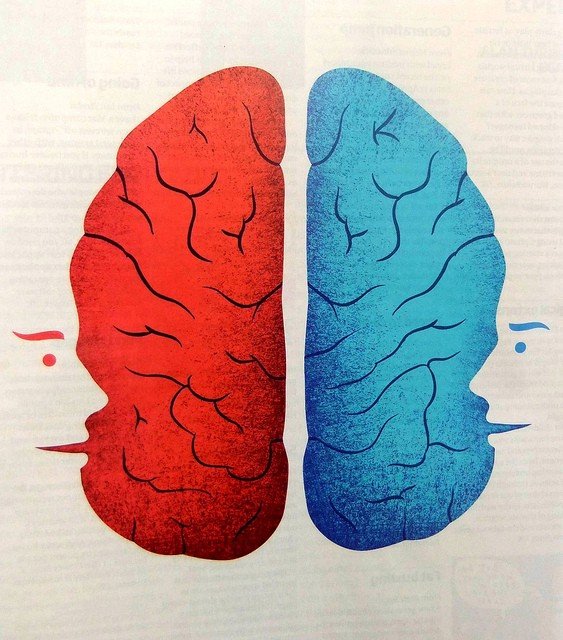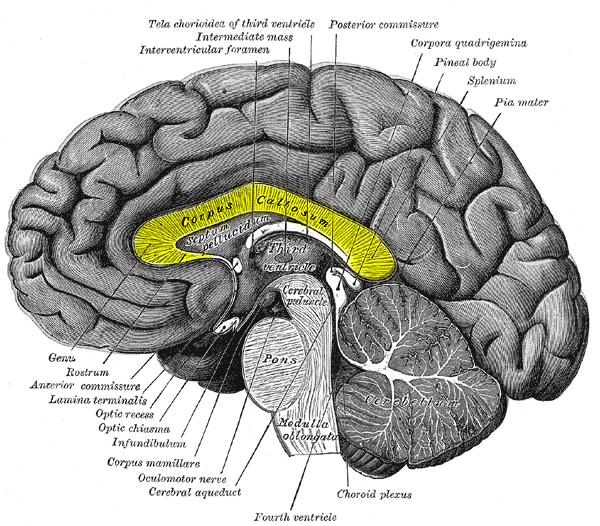Two Minds in One Brain - The Curious Case of Corpus Callosotomy

Did you know that it was possible for the two hemispheres of our brains to be independently conscious — and even to have differing opinions? For one hemisphere to believe in God, and for the other to be an atheist? For one hemisphere to control your hand, whilst the other watches in surprise at this alien appendage moving of its own accord?
The Hemispheric Highway
To understand how this can be possible, we need to understand the structure of the brain. The corpus callosum is a wide, flat bundle of 200–300 million neural fibers connecting the left and right hemispheres of the brain. This hemispheric highway allows them to communicate with one another and coordinate actions and decision-making. This information exchange is important because the two hemispheres are highly specialised and need to be able to share their findings. For example the right hemisphere is responsible for nonverbal and spatial tasks, image and facial recognition and emotion, whereas the left hemisphere excels at language and logic. In a beautiful example of biological symmetry, the right hemisphere is also in control of the sensory functions on left side of our body (our left hand and left visual field), whilst the left hemisphere is in control of our right side.
It has been speculated that Kim Peek (the inspiration for Dustin Hoffman’s ‘Rain Man’) made unusual neural connections due to the absence of his corpus callosum. Incredibly, he had developed independent language areas in both hemispheres and was therefore able to split his vision and allow each of his eyes to read pages of a book separately, at about 8–10 seconds per page!
Split Brain Surgery

Where things get really interesting is when two hemispheres become artificially separated. Corpus callosotomy (or split-brain surgery) is a procedure in which the corpus callosum is severed, breaking the main connection between the two hemispheres. This surgery is normally only carried out as a last resort in patients suffering from severe epileptic seizures, which start in one hemisphere and spread across the whole brain. The purpose of this surgery is to prevent the spread of this electrical storm, and by all accounts it has been shown to be remarkably successful. Following the procedure patients typically report to feel no different and are by all accounts “normal”, including functioning normally in a range of neurological tests.
However, experiments carried out by Sperry and Gazzaniga (1967) in the sixties demonstrated that something very strange was going on. When split-brain subjects are presented with a picture of an object (e.g. an apple) to only their right hemisphere (via their left eye), they were unable to verbally describe the picture, because the speech and language centre is located in the left hemisphere. However if they are asked to reach under a screen with their left hand (controlled by their right hemisphere) to touch various objects, they were able to select the apple without any trouble at all. Furthermore, if they are asked what the object was that they were holding in their left hand, they still were not able to verbalise it.
Even more fascinating is the fact that these patients would attempt to create reasons for why their right hemispheres were making particular decisions outside of their conscious awareness. For example, if they were asked why they chose the apple, they would reason that it was because this was their favourite fruit, or that they had one for lunch that day.
The video below shows these experiments in practise, and it boggles my mind every time I watch it.
A rare side effect of this procedure is a neurological disorder called ‘Alien Hand Syndrome’ — in which one hand appears to be controlled by a separate consciousness with a will of its own. The alien hand will carry out actions without the person’s awareness and outside of their control, which can often lead to a battle between the two hands over what action to take. For example, in one case a patient would put a cigarette into her mouth with her right hand, but before she could light it her left hand would pull it out of her mouth and throw it away!
The evidence thus far leads me naturally to the question — are there two separate sets of conscious experience coexisting within one skull? Is the right hemisphere independently conscious and silently lurking, unable to communicate verbally but still very much aware? The clip below from a talk by neurologist VS Ramachandran explains the incredible case of one split brain patient where his right hemisphere believed in god, but his left hemisphere was an atheist.
Spooky Implications
It is quite spooky to consider that there must be some point during the callosotomy procedure (which incidentally, people can elect to stay awake for) when the individual branches into two separate sets of consciousness, both completely unaware of the others’ existence. Does either hemisphere notice a difference, or feel a sense of loss?
However, what really gives me goosebumps is in wondering — are our minds already split in some sense? Are we are already not the only “I” within our own our minds? After all, as Sam Harris notes in ‘Waking Up’, even in a healthy brain, our two individual hemispheres are only sharing an executive summary of their processes with each other via the corpus callosum, rather than a full information exchange. This points to the possibility that our two hemispheres are already functioning independently to some extent.
Take a moment to absorb how bizarre this possibility is. The point of view from which you are consciously reading these words may not be the only conscious point of view to be found in your brain. It is one thing to say that you are unaware of a vast amount of activity in your brain. It is quite another to say that some of this activity is aware of itself and is watching your every move.”
Sam Harris — Waking Up (Chapter 1 is available for free on his blog)
Experiments conducted by Miller and Gazzaniga in 2009 suggested that the two brain hemispheres do indeed have differing opinions when it comes to making moral judgements. Subjects were told a series of stories, each involving either intentional or accidental harm. In the first story, an individual intends to poison his boss but fails because he mistakes sugar for rat poison, and in the second an individual accidentally kills his boss by mistaking rat poison for sugar. Whilst most people would conclude that the intentional harm was more morally reprehensible, when the story was read aloud to a split brain patient (and thereby only directed to the left hemisphere) they concluded that both stories were morally equal. It appears that we require an interaction between the two hemispheres in order to come to a sound moral assessment.
But this makes me wonder, what is the process behind how these two ‘hemispheric opinions’ are combined to reach our final conclusions? Have you ever been in a situation where you felt really torn about what you should do; when logically you knew what the right course of action should be, but your ‘gut’ was telling you to do the opposite? On these occasions, are we simply the spectators of an ongoing hemispheric battle?
Recent Updates
A recent publication in Brain by Pinto et al (2017) indicates that researchers are also split on whether consciousness is truly divided in split brain patients. Pinto and his colleagues argue that it is in fact visual perception that is divided, rather than consciousness itself, a viewpoint that has been rejected by Gazzaniga et al. Dr. Michael Corballis has recently hypothesised that both sets of authors have been overlooking the role of subcortical connections, which remain intact when the main cortical connections are severed. He argues that these connections maintain an element of visual unity in split brain patients, and may explain the apparent integration of vision in some patients.
Corballis also notes that as drug treatments for epilepsy have become increasingly effective, fewer and fewer split brain surgeries have been taking place. Looking ahead to the future, it could be that many of the questions surrounding this mystery will never be answered.
Thanks for reading
I will be continuing to publish similar content in the upcoming weeks, so be sure to follow if you'd like more posts about philosophy, cosmology and consciousness. This post was also published on Medium, and is an expanded and updated version of my own work. References are included in links within the text. If you want to follow me elsewhere you can find me at:
Twitter - @ongoingwow
Medium - @ongoingwow
Instagram - @ongoingwow
Congratulations @ongoingwow! You have completed some achievement on Steemit and have been rewarded with new badge(s) :
Click on any badge to view your own Board of Honor on SteemitBoard.
For more information about SteemitBoard, click here
If you no longer want to receive notifications, reply to this comment with the word
STOPHello & Cheers!! I'm a content detection and information bot. You are receiving this reply because a short link or links have been detected in your post/comment. The purpose of this message is to inform your readers and yourself about the use of and dangers of short links.
To the readers of the post: Short links are provided by url shortening services. The short links they provide can be useful in some cases. Generally their use is benign. But as with all useful tools there are dangers. Short links can be used to hide all sorts of things. Quite frequently they are used to hide referral links for instance. While not dangerous this can be deceptive. They can also be used to hide dangerous links such as links to phishing sites, sites loaded with malware, scam sites, etc. You should always be extremely cautious before clicking on one. If you don't know and trust the poster don't click. Even if you do you should still be cautious and wary of any site you are sent to. It's always better to visit the site directly and not through a short link.
To the author of the post: While short links may be useful on some sites they are not needed on steemit. You can use markdown to format your links such as this link to steemit. It's as simple as
[steemit](https://steemit.com)Unlike short links this allows the reader to see where they are going by simply hovering over the link before they click on it.Fair enough - this was for one of the image source links, just because the URL was so long it was irritating me in Markdown, haha! I've updated it to show the long link :)
Hi! I am a robot. I just upvoted you! I found similar content that readers might be interested in:
https://medium.com/@ongoingwow/mind-the-gap-split-brains-and-divided-consciousness-3b6f846b9939
Thanks Cheetah, this is an older version of this piece that I wrote. I wanted to give it a bit of an overhaul, with better referencing and an update on where current researchers stand on this topic. The new Medium article is here (https://medium.com/@ongoingwow/two-minds-in-one-brain-the-curious-case-of-corpus-callostomy-6b31967ccd) and links back to this Steemit post as the original source.
@OriginalWorks
The @OriginalWorks bot has determined this post by @ongoingwow to be original material and upvoted(1.5%) it!
To call @OriginalWorks, simply reply to any post with @originalworks or !originalworks in your message!